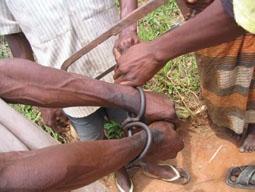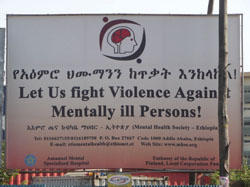18.6.2 How do I raise awareness within the community?
When you arrange an awareness-raising meeting in your community, a useful approach could be to find someone who has had successful treatment for mental illness and see if they would be willing to tell their story in public. The photographs in Figure 18.4 and Figure 18.5 give you some ideas for raising awareness on specific issues facing people with mental illness.


Guided Activity 18.1 Awareness-raising.
Table 18.2 gives a structure for an awareness-raising meeting in your community. Some of the boxes have been completed to get you started and others have been left empty for your own suggestions. Think of what you would say in each part of the meeting, and complete the empty boxes. Write about your experience of trying this technique in your Study Diary and discuss it with your Tutor at the next Study Support Meeting.
| Structure | Examples of what you might say |
|---|---|
Introduce the topic | ‘Today I am going to tell you about the important topic of mental illness’ |
Find out what people already know | ‘Is mental illness a problem in your community?’ ‘What causes of mental illness do you know about?’ |
Explain why mental illness is important | ‘Mental illness is common and causes a lot of suffering’ ‘Anybody can be affected by mental illness during their life’ ‘Mental illness stops a person from living a full life’ ‘People with mental illness are more likely to have poor health and die young’ |
Explain about the different types of mental illness | |
Explain how people can reduce their risk of developing mental illness (primary prevention) | |
Explain why it is important to identify people with mental illness (secondary prevention) | ‘Mental illness can be treated in a health facility, just like a physical illness’ ‘The earlier that treatment is started, the quicker and better the person will recover’ |
Discuss the treatments for mental illness (tertiary prevention) | ‘People with mental illness need to continue with their medication, even if they also have traditional treatments’ ‘Some traditional remedies can be harmful e.g. beating’ ‘As well as medication, people with mental illness need care and support from people around them’ ‘If the person has treatment then they don’t need to be chained up at home’ |
Explain about the negative effect of stigma, discrimination or abuse (secondary and tertiary prevention) | |
Explain how the community can help (secondary and tertiary prevention) | ‘You can help to encourage people with mental illness to go to a health facility and take medication’ ‘You can help by being a friend to the person with mental illness – make them feel included in community life’ ‘You can help by supporting the family of the mentally ill person’ |
In the last study session in this Module you will learn about disability and community rehabilitation.
18.6.1 Who needs to know?
